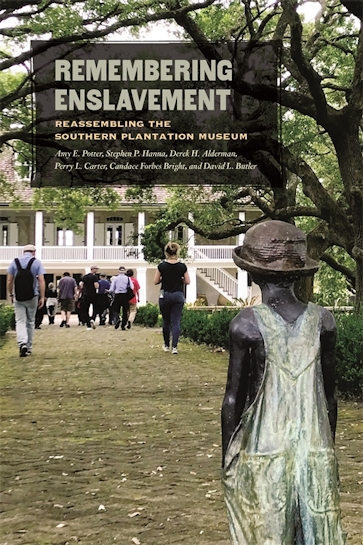Remembering Enslavement: Reassembling the Southern Plantation Museum. Amy E. Potter, Stephen P. Hanna, Derek H. Alderman, Perry L. Carter, Candance Forbes Bright, and David L. Butler. Athens, Georgia: University of Georgia Press, 2022.
REVIEWED BY MARY GLISSON

In the wake of the brutal public murder of George Floyd and the Black Lives Matter protests that followed, it is important now more than ever to understand the way slavery is taught and interpretated in America, particularly in plantation museums. In Potter et al.’s Remembering Enslavement: Reassembling the Southern Plantation Museum, this research team conducted fieldwork at fifteen plantation museums to understand the everchanging place of enslavement’s history, the interpretation strategies, and how it is viewed through stakeholder lenses. They also conducted this work through the understanding that the legacies of slavery are key to the infrastructure that continues to harm African Americans today.
In Chapter 1 the researchers explain the framework under which they are gathering their research. They had decided that in order to understand how the plantation museum is engaging with slavery they must examine the whole assemblage which brings together every competent in the experience such as marketing, tour guides, the physical space, objects, etc. Chapter 2 is where they explain how they would be conducting the research, what data would be recorded, how it would be evaluated, and how the plantation sites they used were chosen. Chapter 3-5 goes through the three regions where the 13 plantations were located. In each chapter they give a history and importance of the region and of the specific sites. They then analyze all the data that they collected from each site such as demographics of visitors, how tours were conducted, how staff was trained, and the physical aspects of the site. Chapter 6 was similar to the previous three however the sites researched were two counter-narrative plantation museums that were designed to center African American stories.
In chapter 7 the researchers take the data they collected from the traditional plantation sites versus the counter-narrative sites to point out specific areas of intervention. Through the many components examined they concluded that management was the key role in any efforts to “more fully and justly tells the history of slavery and commemorates the enslaved” (277). One example of managerial issues was a lack of retraining and evaluating tour guides leading to many staff being unwilling or unsure if or how to bring up slavery at all. They also explored specific points of resistance they have found in the traditional plantation site that interfere with centering slavery. From these findings the chapter ends with different areas of questioning that museums can use to help identify their own areas of need surrounding slavery. The book concludes with an afterword that describes the changes or lack of change that researchers found when they returned to the main 13 plantation in the immediate years after the fieldwork had been given to the plantations. Changes made to better center slavery were found to be lacking and did not incorporate change into the entire assemblage which the researchers found would be the most effective approach.
This comprehensive study of how plantation assemblages impact the way visitors understand slavery is extremely important for not only plantation museums and museums that interpret slavery but gives strategies that any museum or public history site can use. The thoroughness of this study and the detail that is given reflects the importance that the researchers had for this project and how deeply they cared about the topic. It gave a very clear template one could use to examine their own museum by explaining why each piece of the assemblage was examined and the way it impacts the overall experience.
The amount of time spent on the idea of the assemblage was well used along with the fact that they make clear through this entire research process that they were pushing back against the idea that by simply addressing one or a few areas of the museum justice can be done. One aspect of the book that can lessen the effectiveness of the information is the way that chapter 3-5 are laid out to discuss the tradition plantation museums in each region. There is such a depth of information given to start each chapter where geography, each plantation’s history, and then regional context is discussed before getting into the data collected. By the time you reach specific information that was collected, you may have forgotten the plantations’ names that are being discussed.
It is stated in the book that the goal of the project was to document and intervene in plantation museum assemblages. They say that some of the plantations’ management have reached out for help in these efforts and specifics of what they suggested was not given, but from reading the Afterword it seems as though their interventions have accomplished little so far. Plantation museums can and should be moved by this book and implement the ideas from it into their interpretation of slavery. The direct change that occurred in the plantation museums researched appears to have been quite minimal however. Part of their goal of intervention may be accomplished by other museum professionals who take this information and use it in their own museum assemblages.
Mary Glisson is a first year MA student in the IU Indianapolis Museum Studies Program.

